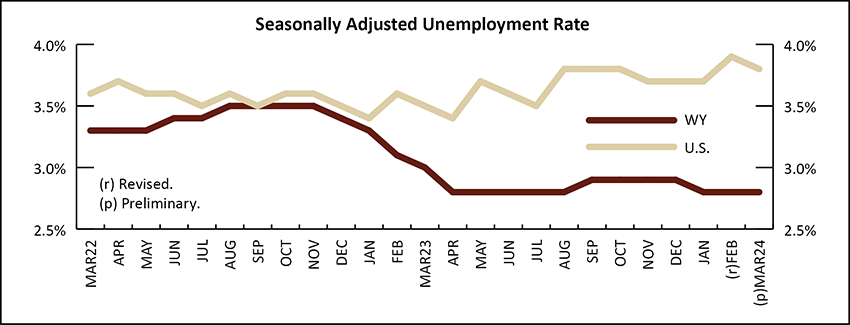Wyoming Labor Force Trends
May 2024 | Volume 61, No. 5
Click Here for PDF
Return to Table of Contents
Wyoming Unemployment Unchanged at 2.8% in March 2024
by: David Bullard, Senior Economist
The Research & Planning section of the Wyoming Department of Workforce Services reported that the state’s seasonally adjusted1 unemployment rate unemployment rate remained unchanged from February to March at 2.8%. Wyoming’s unemployment rate was slightly lower than its March 2023 level of 3.0% and much lower than the current U.S. unemployment rate of 3.8%.
From February to March, most county unemployment rates followed their normal seasonal pattern and decreased slightly. Unemployment rates often fall in March as warmer weather brings seasonal job gains in construction, professional & business services, and government. The largest unemployment rate decreases occurred in Washakie (down from 4.5% to 4.1%), Sweetwater (down from 4.2% to 3.8%), Sheridan (down from 3.5% to 3.1%), Hot Springs (down from 3.6% to 3.2%), Goshen (down from 3.2% to 2.8%), and Fremont (down from 4.2% to 3.8%) counties.
March 2023 to March 2024, unemployment rates fell in most counties, suggesting a tightening in the state’s labor market. The largest decreases occurred in Washakie (down from 5.0% to 4.1%) and Platte (down from 3.6% to 3.0%) counties. Jobless rates rose slightly in Big Horn (up from 4.2% to 4.4%) and Weston (up from 2.3% to 2.5%) counties.
In March, the highest unemployment rates were found in Big Horn County at 4.4% and Sublette and Washakie counties, each at 4.1%. The lowest unemployment rates were reported in Teton County at 2.1%, Weston County at 2.5%, and Niobrara County at 2.7%.
Current Employment Statistics (CES) estimates show that total nonfarm employment in Wyoming (not seasonally adjusted and measured by place of work) rose from 284,300 in March 2023 to 287,000 in March 2024, an increase of 2,700 jobs (0.9%).
R&P's most recent monthly news release is available at https://doe.state.wy.us/LMI/news.htm.



 Hire Wyo
Hire Wyo